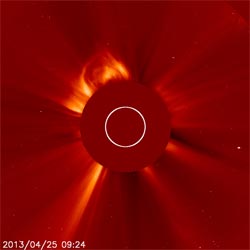The Sun Sends Two CMEs Toward Mercury

The joint ESA and NASA mission the Solar Heliospheric Observatory (SOHO) captured this series of four images of a coronal mass ejection (CME) escaping the sun on the morning of April 25, 2013. The images show the CME from 5:24 a.m. to 6:48 a.m. EDT. This was the second of two CMEs in the space of 12 hours. Both are headed away from Earth toward Mercury. Credit: ESA&NASA/SOHO <br>
Experimental NASA research models show that the first CME began at 9:30 p.m. EDT on April 24. The second CME began at 5:24 a.m. EDT on April 25. Both left the sun traveling at about 500 miles per second and they are headed in the direction of planet Mercury.
While they are not Earth-directed, the CMEs may pass by NASA’s Messenger and STEREO-A and their mission operators have been notified. There may be low levels of particle radiation associated with this event, which is what would normally concern operators of interplanetary spacecraft since the particles can trip computer electronics on board. When warranted, NASA operators can put spacecraft into safe mode to protect the instruments from the solar material.
Updates will be provided as needed.
What is a CME?
For answers to these and other space weather questions, please visit the Spaceweather Frequently Asked Questions page.
Karen C. Fox
NASA's Goddard Space Flight Center, Greenbelt, Md.
Media Contact
All latest news from the category: Physics and Astronomy
This area deals with the fundamental laws and building blocks of nature and how they interact, the properties and the behavior of matter, and research into space and time and their structures.
innovations-report provides in-depth reports and articles on subjects such as astrophysics, laser technologies, nuclear, quantum, particle and solid-state physics, nanotechnologies, planetary research and findings (Mars, Venus) and developments related to the Hubble Telescope.
Newest articles

A universal framework for spatial biology
SpatialData is a freely accessible tool to unify and integrate data from different omics technologies accounting for spatial information, which can provide holistic insights into health and disease. Biological processes…

How complex biological processes arise
A $20 million grant from the U.S. National Science Foundation (NSF) will support the establishment and operation of the National Synthesis Center for Emergence in the Molecular and Cellular Sciences (NCEMS) at…

Airborne single-photon lidar system achieves high-resolution 3D imaging
Compact, low-power system opens doors for photon-efficient drone and satellite-based environmental monitoring and mapping. Researchers have developed a compact and lightweight single-photon airborne lidar system that can acquire high-resolution 3D…





















